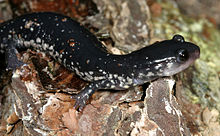- Plethodon glutinosus
-
Northern Slimy Salamander 
Conservation status Scientific classification Kingdom: Animalia Phylum: Chordata Class: Amphibia Order: Caudata Family: Plethodontidae Genus: Plethodon Species: P. glutinosus Binomial name Plethodon glutinosus
(Green, 1818)Synonyms Salamandra glutinosa
Green, 1818
Cylindrosoma glutinosum
Duméril, Bibron, and Duméril, 1854
Plethodon variolosum
Duméril, Bibron, and Duméril, 1854
Salamandra elongata
Duméril, Bibron, and Duméril, 1854
Salamandra melanoleuca
Wied-Neuwied, 1865
Amblystoma melanoleuca
Boulenger, 1882The Northern Slimy Salamander (Plethodon glutinosus) is a species of terrestrial plethodontid salamander found through much of the eastern two thirds of the United States, from New York, west to Illinois, south to Texas, and east to Florida, with an isolated population in southern New Hampshire. It is called slimy because it is capable of excreting a sticky glue-like substance from its skin. It is also sometimes referred to as the Blue-spotted Salamander, Viscid Salamander, Grey-spotted Salamander, or Sticky Salamander depending on which source is consulted. Due to its large geographic range, some taxonomic researchers have suggested splitting Plethodon glutinosus into several distinct species, but this is not widely accepted.
Contents
Description
The Slimy Salamander is typically an overall black in color, with numerous silvery spots or gold spots across its back. They are usually 12-17 cm (4¾-6¾ inches) in length, but can grow to 20.6 cm (8⅛ inches).[1] Males are not easily distinguished from females, though females tend to be slightly larger. They have 15-17 costal grooves.
Behavior
All Plethodonid salamanders are territorial, and will fight aggressively for territory. Their preferred habitat is in moist soil or leaf litter beneath stones, rotting logs or other debris near a permanent water source. They will sometimes make use of other animal's burrows. Their diet consists primarily of ants, beetles, sow bugs, and earthworms, but they will consume most kinds of insect.
Reproduction
Breeding takes place in the spring, and courtship consists of the males performing a sort of dance to attract the female's attention. Females lay clutches of 4 to 12 eggs in a moist area, which she will guard over, often neglecting food for the period until they hatch. Hatchlings emerge from the eggs in approximately 3 months, having no aquatic stage, like many other salamander species. They instead develop straight into their entirely terrestrial adult form. Maturity is not reached for 2–3 years.
References
- ^ Conant, Roger. 1975. A Field Guide to Reptiles and Amphibians of Eastern and Central North America, 2nd edition. Houghton Mifflin. Boston.
External links
Categories:- IUCN Red List least concern species
- Plethodon
- Amphibians of the United States
Wikimedia Foundation. 2010.


